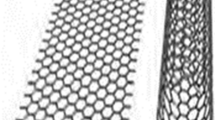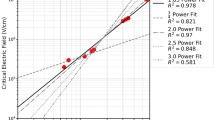Abstract
Carbon nanotube network field-effect transistors (CNT-FETs) have been recognized as strong candidates for post-Si era electronics due to their higher speed, lower power consumption, and high sensing capabilities. In this study, CNT-FET structures were fabricated on heavily doped Si substrates with an oxide layer. To investigate the effect of low-temperature annealing on the electrical properties, the transistors were annealed at 120 °C for 1 h, the transfer and output characteristics of the transistors were measured, and the key electrical parameters, such as field-effect mobility, effective mobility, threshold voltage, interface states, transconductance, drain conductance, resistance, and hysteresis gap values were obtained. A series of device parameter evaluation results showed that low-temperature annealing treatment in air can effectively improve the on-state current, increase the mobility, and reduce the device threshold voltage and subthreshold swing. In addition, a large decrease in contact resistance, from 1.9 MΩ to 12.3 kΩ, was observed after low-temperature annealing. It has been found that low-temperature annealing has a tremendous improvement effect on the electrical characteristics of CNT-FETs and should be considered during the production and design stages of CNT transistors.
Graphical Abstract













Similar content being viewed by others
References
P. Sakalas, M. Claus, M. Schroter, and A. Rumiantsev, Experimental characterization of temperature-dependent electron transport in single-wall multi-tube carbon nanotube transistors. Phys. Status Solidi (RRL) Rapid Res. Lett. 6(2), 62 (2012).
N.R. Pradhan, H. Duan, J. Liang, and G.S. Iannacchione, The specific heat and effective thermal conductivity of composites containing single-wall and multi-wall carbon nanotubes. Nanotechnology 20(24), 245705 (2009).
B. Kim, J. Lee, S. Namgung, J. Kim, J.Y. Park, M.S. Lee, and S. Hong, DNA sensors based on CNT-FET with floating electrodes. Sens. Actuators B Chem. 169, 182 (2012).
L.N. Lisetski, S.S. Minenko, A.P. Fedoryako, and N.I. Lebovka, Dispersions of multiwalled carbon nanotubes in different nematic mesogens: the study of optical transmittance and electrical conductivity. Physica E 41(3), 431 (2009).
Z. Zhu, Y.C. Chan, Z. Chen, C.L. Gan, and F. Wu, Effect of the size of carbon nanotubes (CNTs) on the microstructure and mechanical strength of CNTs-doped composite Sn0.3Ag0.7Cu-CNTs solder. Mater. Sci. Eng. A 727, 160 (2018).
T.W. Ebbesen, Carbon nanotubes. Annu. Rev. Mater. Sci. 24(1), 235 (1994).
C.G. Almudever and A. Rubio, Variability and reliability analysis of CNFET technology: impact of manufacturing imperfections. Microelectron. Reliab. 55(2), 358 (2015).
G.J. Choi, T.M. Gwon, D.H. Kim, J. Park, S.M. Kim, S.H. Oh, and S.J. Kim, CNT bundle-based thin intracochlear electrode array. Biomed. Microdevice 21, 1 (2019).
M. Tuo, L. Wang, M.R. Amer, X. Yu, S.B. Cronin, and H. Xin, Suspended individual SWCNT characterization via bottom gate FET configuration. Microw. Opt. Technol. Lett. 59(10), 2610–2614 (2017).
N. Rani, K. Khurana, and N. Jaggi, Impact of γ-irradiation on the structural and electrical characteristics of functionalized multiwalled carbon nanotubes. Mater. Sci. Semicond. Process. 151, 106999 (2022).
M.H. Yang, K.B. Teo, L. Gangloff, W.I. Milne, D.G. Hasko, Y. Robert, and P. Legagneux, Advantages of top-gate, high-k dielectric carbon nanotube field-effect transistors. Appl. Phys. Lett. 88(11), 113507 (2006).
G. Ruffini, S. Dunne, E. Farrés, J. Marco-Pallarés, C. Ray, E. Mendoza, and C. Grau, A dry electrophysiology electrode using CNT arrays. Sens. Actuators A 132(1), 34 (2006).
S.J. Tans, A.R. Verschueren, and C. Dekker, Room-temperature transistor based on a single carbon nanotube. Nature 393(6680), 49 (1998).
R. Seidel, M. Liebau, G.S. Duesberg, F. Kreupl, E. Unger, A.P. Graham, and W. Pompe, In-situ contacted single-walled carbon nanotubes and contact improvement by electroless deposition. Nano Lett. 3(7), 965 (2003).
D.N. Madsen, K. Mølhave, R. Mateiu, A.M. Rasmussen, M. Brorson, C.J. Jacobsen, and P. Bøggild, Soldering of nanotubes onto microelectrodes. Nano Lett. 3(1), 47 (2003).
Y. Woo, G.S. Duesberg, and S. Roth, Reduced contact resistance between an individual single-walled carbon nanotube and a metal electrode by a local point annealing. Nanotechnology 18(9), 095203 (2007).
K. Yu, G. Lu, K. Chen, S. Mao, H. Kim, and J. Chen, Controllable photoelectron transfer in CdSe nanocrystal–carbon nanotube hybrid structures. Nanoscale 4(3), 742 (2012).
Z. Hou, Y. Liu, G. Niu, Y. Sun, J. Li, J. Zhao, and S. Wu, Carbon nanotube network film-based field-effect transistor interface state optimization by ambient air annealing. J. Appl. Phys. 133(12), 125303 (2023).
R.S. Park, M.M. Shulaker, G. Hills, L. Suriyasena Liyanage, S. Lee, A. Tang, and H.S.P. Wong, Hysteresis in carbon nanotube transistors: measurement and analysis of trap density, energy level, and spatial distribution. ACS Nano 10(4), 4599 (2016).
J.O. Lee, C. Park, J.J. Kim, J. Kim, J.W. Park, and K.H. Yoo, Formation of low-resistance ohmic contacts between carbon nanotube and metal electrodes by a rapid thermal annealing method. J. Phys. D Appl. Phys. 33(16), 1953 (2000).
V.S. Gangoli, C.J. Barnett, J.D. McGettrick, A. Orbaek White, and A.R. Barron, Increased electrical conductivity of carbon nanotube fibers by thermal and voltage annealing. C 8(1), 1 (2021).
D. Yokoyama, T. Iwasaki, K. Ishimaru, S. Sato, T. Hyakushima, M. Nihei, and H. Kawarada, Electrical properties of carbon nanotubes grown at a low-temperature for use as interconnects. Jpn. J. Appl. Phys. 47(4), 1985 (2008).
T. Pei, Z. Zhang, Z. Wang, L. Ding, S. Wang, and L.M. Peng, Temperature performance of doping-free top-gate CNT field-effect transistors: potential for low-and high-temperature electronics. Adv. Funct. Mater. 21(10), 1843 (2011).
D. Estrada, S. Dutta, A. Liao, and E. Pop, Reduction of hysteresis for carbon nanotube mobility measurements using pulsed characterization. Nanotechnology 21(8), 085702 (2010).
A.V. Krasheninnikov, K. Nordlund, and J. Keinonen, Production of defects in supported carbon nanotubes under ion irradiation. Phys. Rev. B 65(16), 165423 (2002).
C.W. Jang, Y.T. Byun, D.H. Woo, S. Lee, and Y.M. Jhon, Enhanced adhesion between carbon nanotubes and substrate surfaces by low-temperature annealing. J. Korean Phys. Soc. 61, 2096 (2012).
W.B. Choi, B.H. Cheong, J.J. Kim, J. Chu, and E. Bae, Selective growth of carbon nanotubes for nanoscale transistors. Adv. Funct. Mater. 13(1), 80 (2003).
H. Altuntas, K. Snashall, F. Oke-Altuntas, I. Jayawerdane, M.O. Tas, and S.R.P. Silva, Effect of pyrene-1 boronic acid functionalization on the electrical characteristics of carbon nanotube field-effect transistor. Electron. Mater. Lett. 19(5), 405 (2023).
J.S. Chen, V. Stolojan, and S.R.P. Silva, Towards type-selective carbon nanotube growth at low substrate temperature via photo-thermal chemical vapour deposition. Carbon 84, 409 (2015).
M.S. Dresselhaus, G. Dresselhaus, A. Jorio, A.G. Souza Filho, M.A. Pimenta, and R. Saito, Single nanotube Raman spectroscopy. Acc. Chem. Res. 35(12), 1070 (2002).
S. Costa, E. Borowiak-Palen, M. Kruszynska, A. Bachmatiuk, and R.J. Kalenczuk, Characterization of carbon nanotubes by Raman spectroscopy. Mater. Sci. Pol. 26(2), 433 (2008).
V.W. Brar, G.G. Samsonidze, M.S. Dresselhaus, G. Dresselhaus, R. Saito, A.K. Swan, and A. Jorio, Second-order harmonic and combination modes in graphite, single-wall carbon nanotube bundles, and isolated single-wall carbon nanotubes. Phys. Rev. B 66(15), 155418 (2002).
C.S. Allen, G. Liu, Y. Chen, A.W. Robertson, K. He, K. Porfyrakis, and J.H. Warner, Optically enhanced charge transfer between C 60 and single-wall carbon nanotubes in hybrid electronic devices. Nanoscale 6(1), 572 (2014).
E. Fortunato, P. Barquinha, and R. Martins, Oxide semiconductor thin-film transistors: a review of recent advances. Adv. Mater. 24(22), 2945 (2012).
F. Schwierz, Graphene transistors: status, prospects, and problems. Proc. IEEE 101(7), 1567 (2013).
İ Karteri, Ş Karataş, and F. Yakuphanoğlu, Electrical characterization of graphene oxide and organic dielectric layers based on thin film transistor. Appl. Surf. Sci. 318, 74 (2014).
G. Horowitz and P. Delannoy, An analytical model for organic-based thin-film transistors. J. Appl. Phys. 70(1), 469 (1991).
M. Shur, Physics of Semiconductor Devices (Englewood Cliffs: Prentice Hall Inc., 1990), p.680.
M.M. Billah, A.B. Siddik, J.B. Kim, D.K. Yim, S.Y. Choi, J. Liu, and J. Jang, High-performance coplanar dual-channel a-InGaZnO/a-InZnO semiconductor thin-film transistors with high field-effect mobility. Adv. Electron. Mater. 7(3), 2000896 (2021).
C.T. Xuan, N.T. Thuy, T.T. Luyen, T.T. Huyen, and M.A. Tuan, Carbon nanotube field-effect transistor for DNA sensing. J. Electron. Mater. 46, 3507 (2017).
I.G. Baek, M.S. Lee, S. Seo, M.J. Lee, D.H. Seo, D.S. Suh, and J.T. Moon, Highly scalable nonvolatile resistive memory using simple binary oxide driven by asymmetric unipolar voltage pulses. In IEDM Technical Digest. IEEE International Electron Devices Meeting (2004), pp. 587–590.
Z. Wang, H. Xu, Z. Zhang, S. Wang, L. Ding, Q. Zeng, and L.M. Peng, Growth and performance of yttrium oxide as an ideal high-κ gate dielectric for carbon-based electronics. Nano Lett. 10(6), 2024 (2010).
P. Avouris, Molecular electronics with carbon nanotubes. Acc. Chem. Res. 35(12), 1026 (2002).
A.D. Franklin, D.B. Farmer, and W. Haensch, Defining and overcoming the contact resistance challenge in scaled carbon nanotube transistors. ACS Nano 8(7), 7333 (2014).
P.Y. Gangavarapu, A.M.R. Sharma, K.L. Ganapathi, S. Mohan, and A.K. Naik, Dielectric based charge carrier tuning for CNT CMOS inverters. Semicond. Sci. Technol. 34(1), 015015 (2018).
M. Toader, S. Hermann, L. Scharfenberg, M. Hartmann, M. Mertig, S.E. Schulz, and T. Gessner, Competitive impact of nanotube assembly and contact electrodes on the performance of cnt-based fets. J. Phys. Chem. C 120(18), 10020 (2016).
Acknowledgments
H. Altuntas and F. Oke-Altuntas gratefully acknowledges TUBITAK BIDEB 2219 Fellowship and Advanced Technology Institute (ATI) for their cooperation.
Author information
Authors and Affiliations
Corresponding authors
Ethics declarations
Conflict of interest
The authors declare that they have no known competing financial interests or personal relationships that could have appeared to influence the work reported in this paper.
Additional information
Publisher's Note
Springer Nature remains neutral with regard to jurisdictional claims in published maps and institutional affiliations.
Rights and permissions
Springer Nature or its licensor (e.g. a society or other partner) holds exclusive rights to this article under a publishing agreement with the author(s) or other rightsholder(s); author self-archiving of the accepted manuscript version of this article is solely governed by the terms of such publishing agreement and applicable law.
About this article
Cite this article
Altuntas, H., Oke-Altuntas, F. & Silva, S.R.P. The Effect of Low-Temperature Annealing on the Electrical Characteristics of Carbon Nanotube Network Field-Effect Transistors. J. Electron. Mater. 53, 2104–2114 (2024). https://doi.org/10.1007/s11664-023-10912-x
Received:
Accepted:
Published:
Issue Date:
DOI: https://doi.org/10.1007/s11664-023-10912-x




